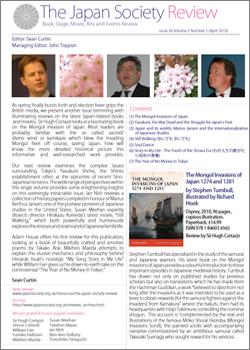Issue 26 (April 2010, Volume 5, Number 2)

As spring finally bursts forth and election fever grips the British media, we present another issue brimming with illuminating reviews on the latest Japan-related books and movies. Sir Hugh Cortazzi looks at a fascinating book on the Mongol invasion of Japan. Most readers are probably familiar with the so called sacred/ divine wind or kamikaze which blew the invading Mongol fleet off course, saving Japan. Few will know the more detailed historical picture this informative and well-researched work provides.
Our next review examines the complex issues surrounding Tokyo’s Yasukuni Shrine, the Shinto establishment often at the epicentre of recent Sino- Japanese tensions. The wide range of perspectives within this single volume provides some enlightening insights on this seemingly intractable issue. Ian Nish reviews a collection of history papers compiled in honour of Marius Berthus Jansen, one of the postwar pioneers of Japanese studies in the United States. Susan Meehan expertly dissects director Hirokazu Koreeda’s latest movie, “Still Walking,” which both powerfully and humorously explores the stresses and strains and of Japanese family life.
Adam House offers his first review for this publication, looking at a book of beautifully crafted and emotive poems by Takako Arai. Mikihiro Maeda attempts to explain the elusive mechanics and philosophy behind Hiroyuki Itsuki’s nostalgic “My Song Story in My Life” while William Farr gives us his down-to-earth take on the controversial “The Year of No Money in Tokyo.”
Contents
- The Mongol Invasions of Japan
- Yasukuni, the War Dead and the Struggle for Japan’s Past
- Japan and its worlds: Marius Jansen and the Internationalization of Japanese Studies
- Still Walking (歩いても 歩いても)
- Soul Dance
- Story in My Life - The Youth of the Showa Era (わが人生の歌がた り 昭和の青春)
- The Year of No Money in Tokyo
Contributors
Editor
Sean Curtin
Managing Editor
John Toppon
Reviewers
Sir Hugh Cortazzi, Sean Curtin, Ian Nish, Susan Meehan, Adam House, Mikihiro Maeda and William Farr

